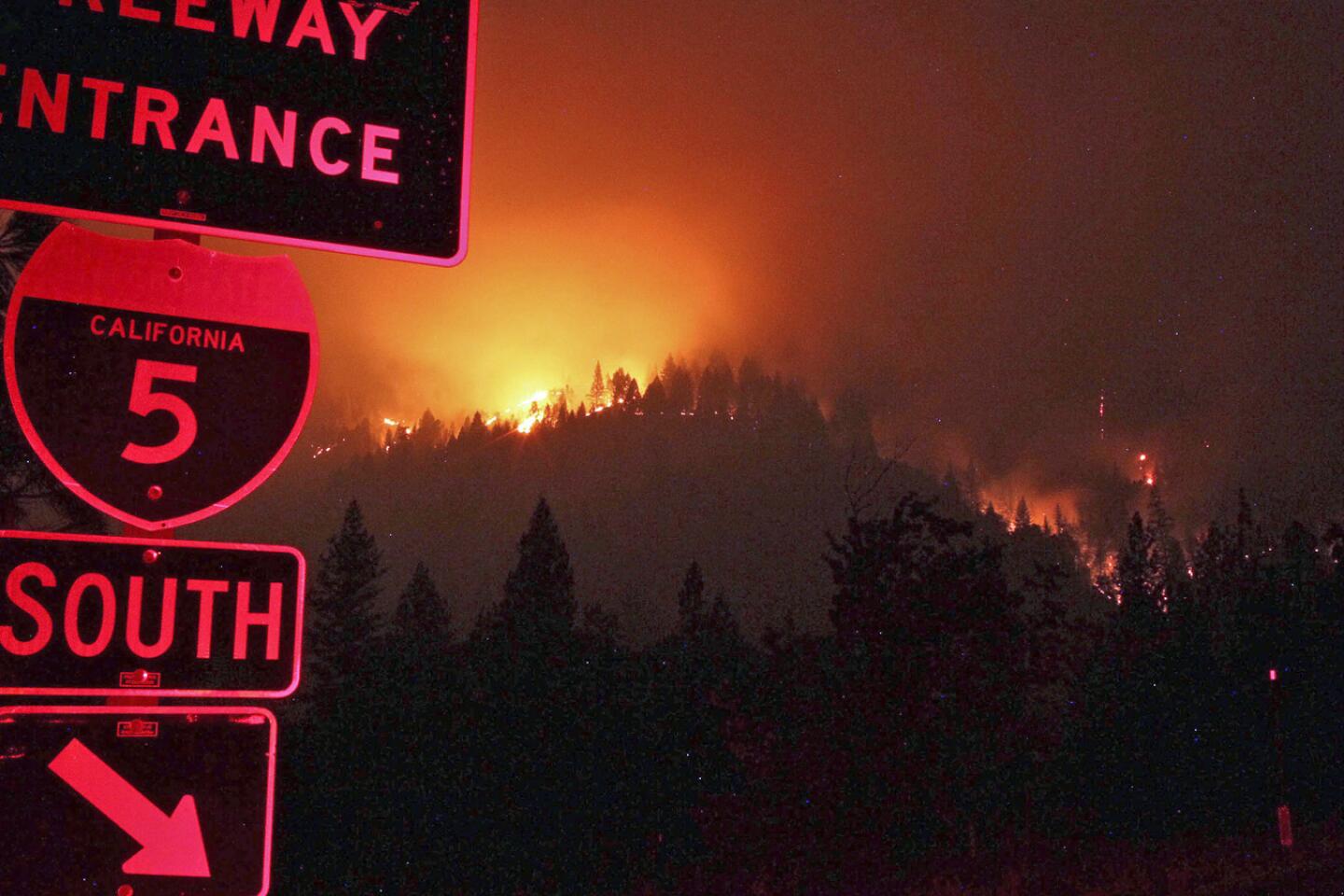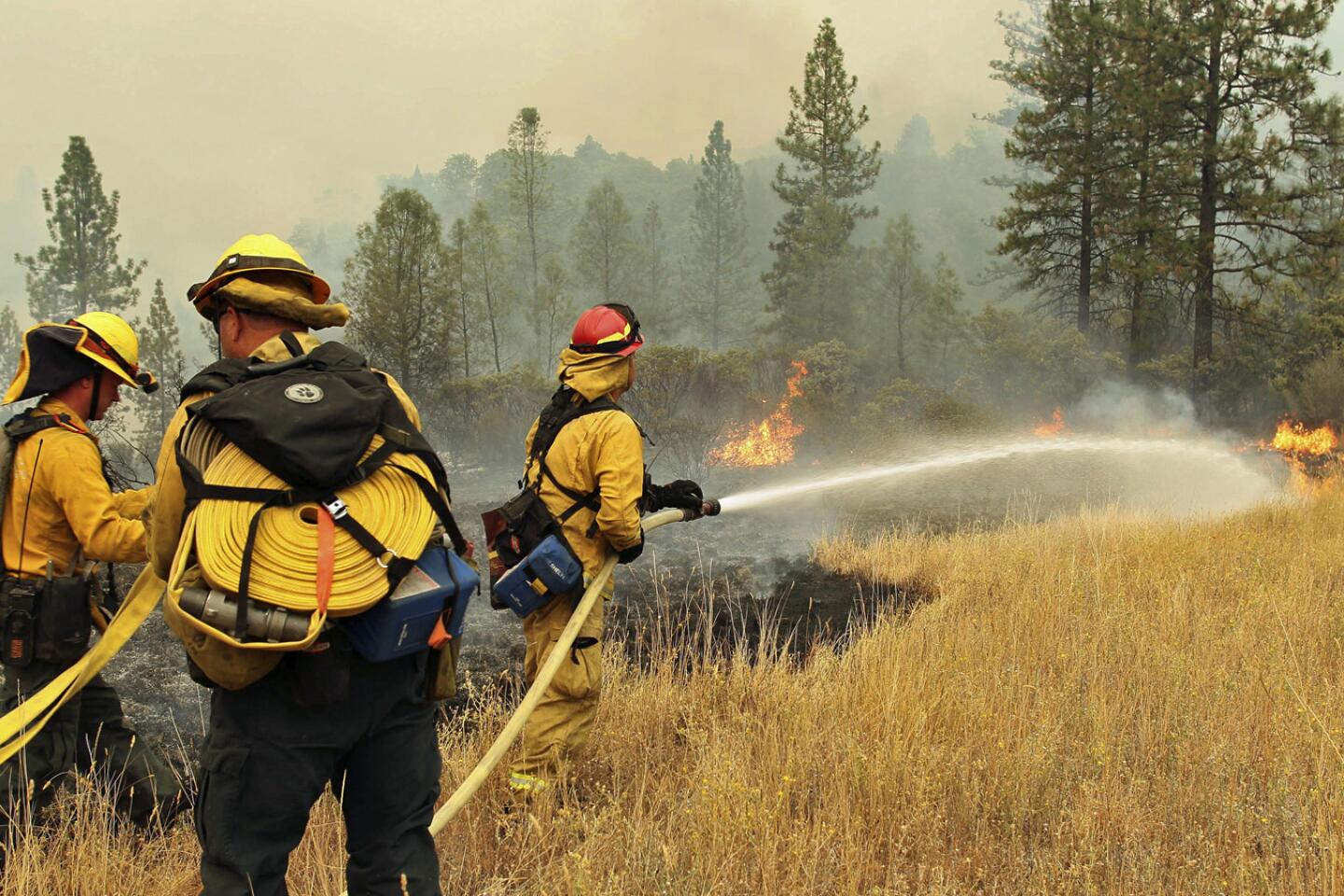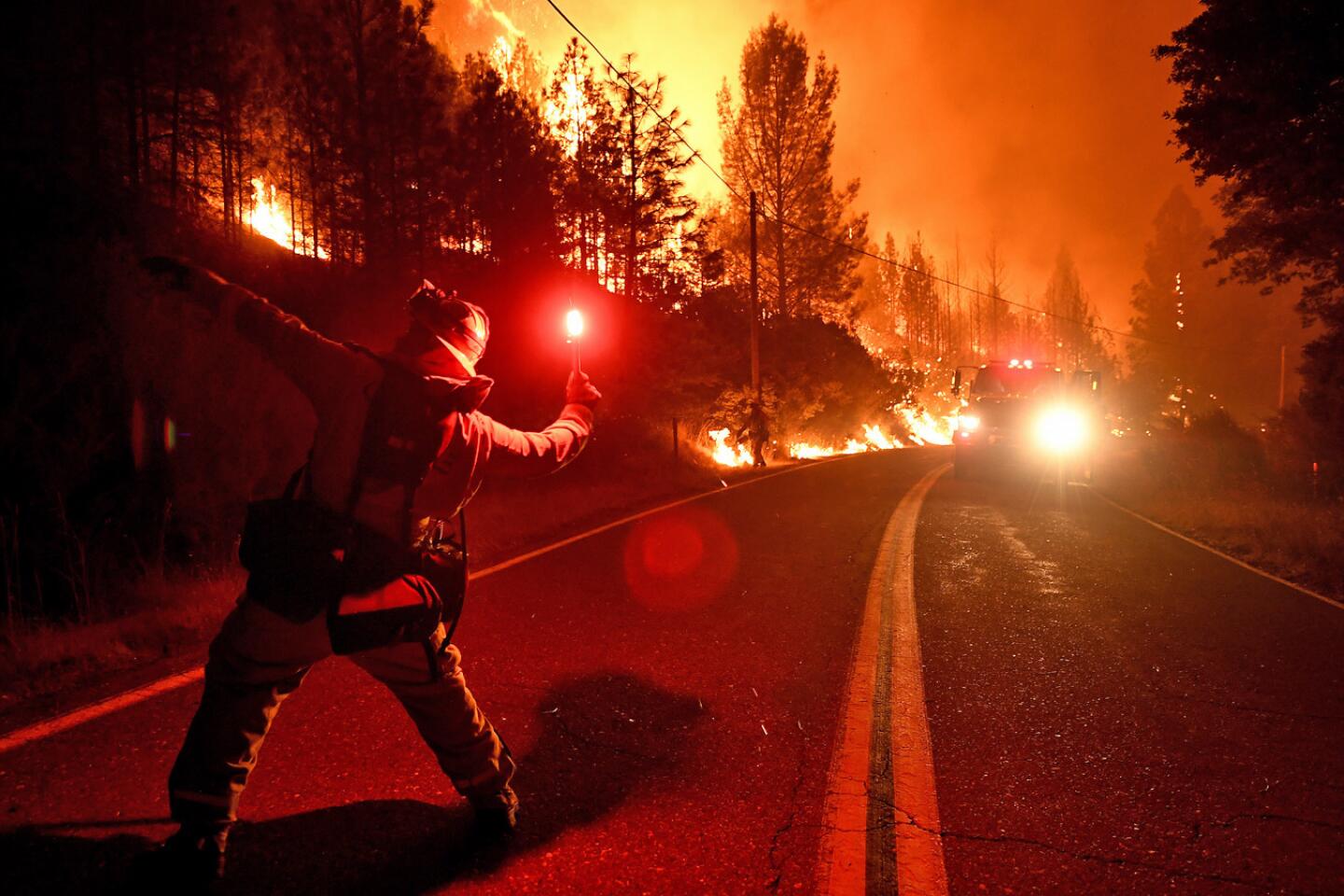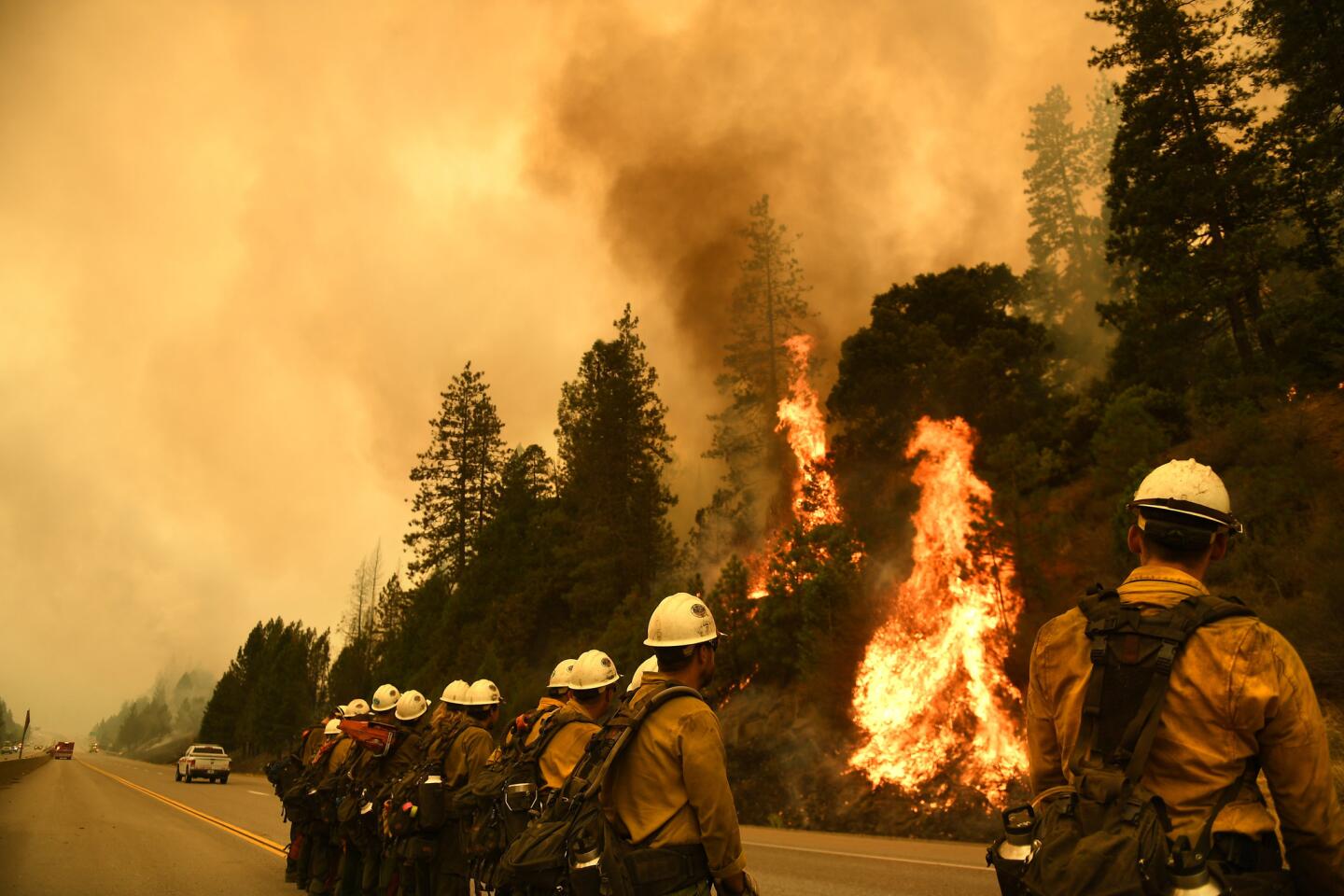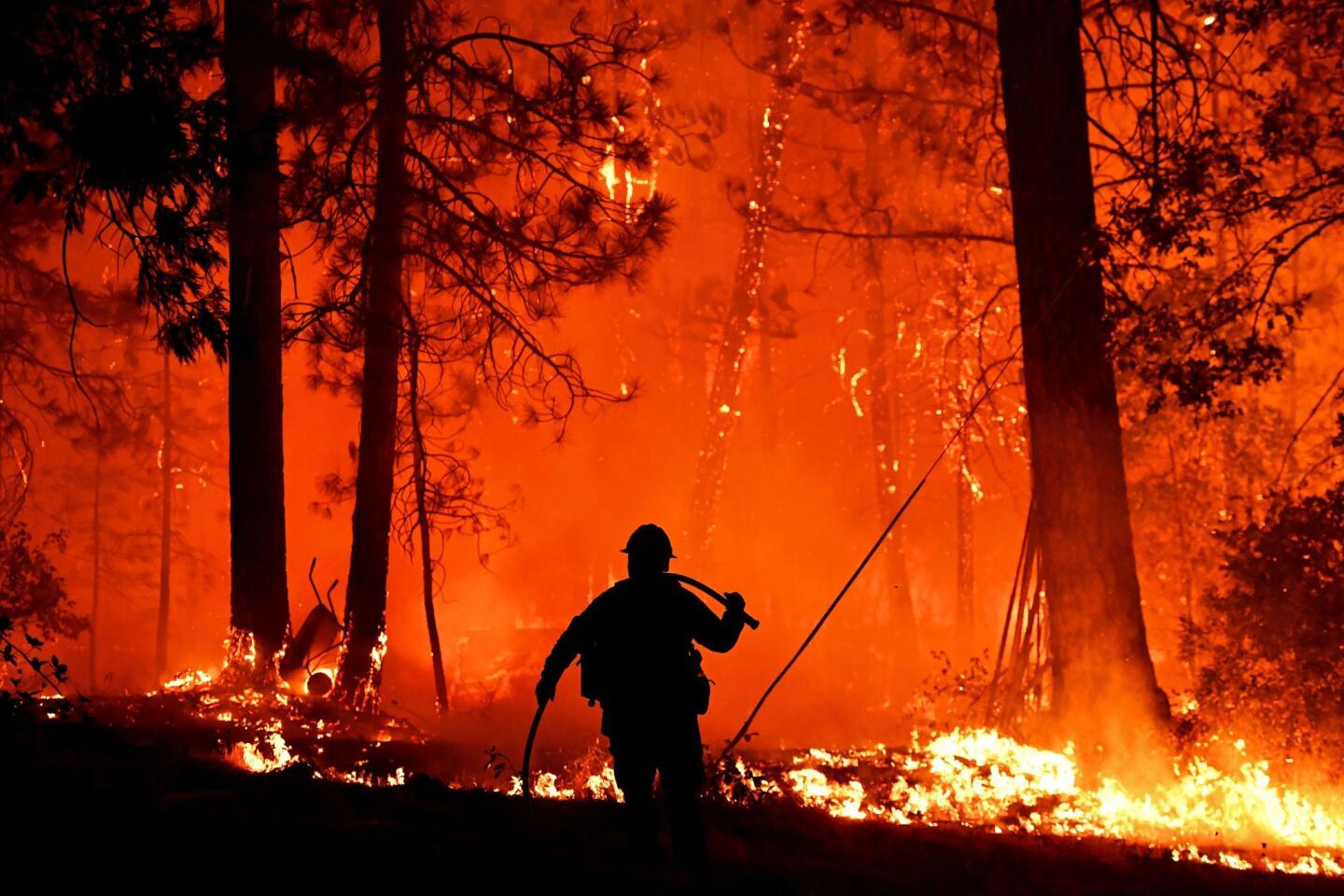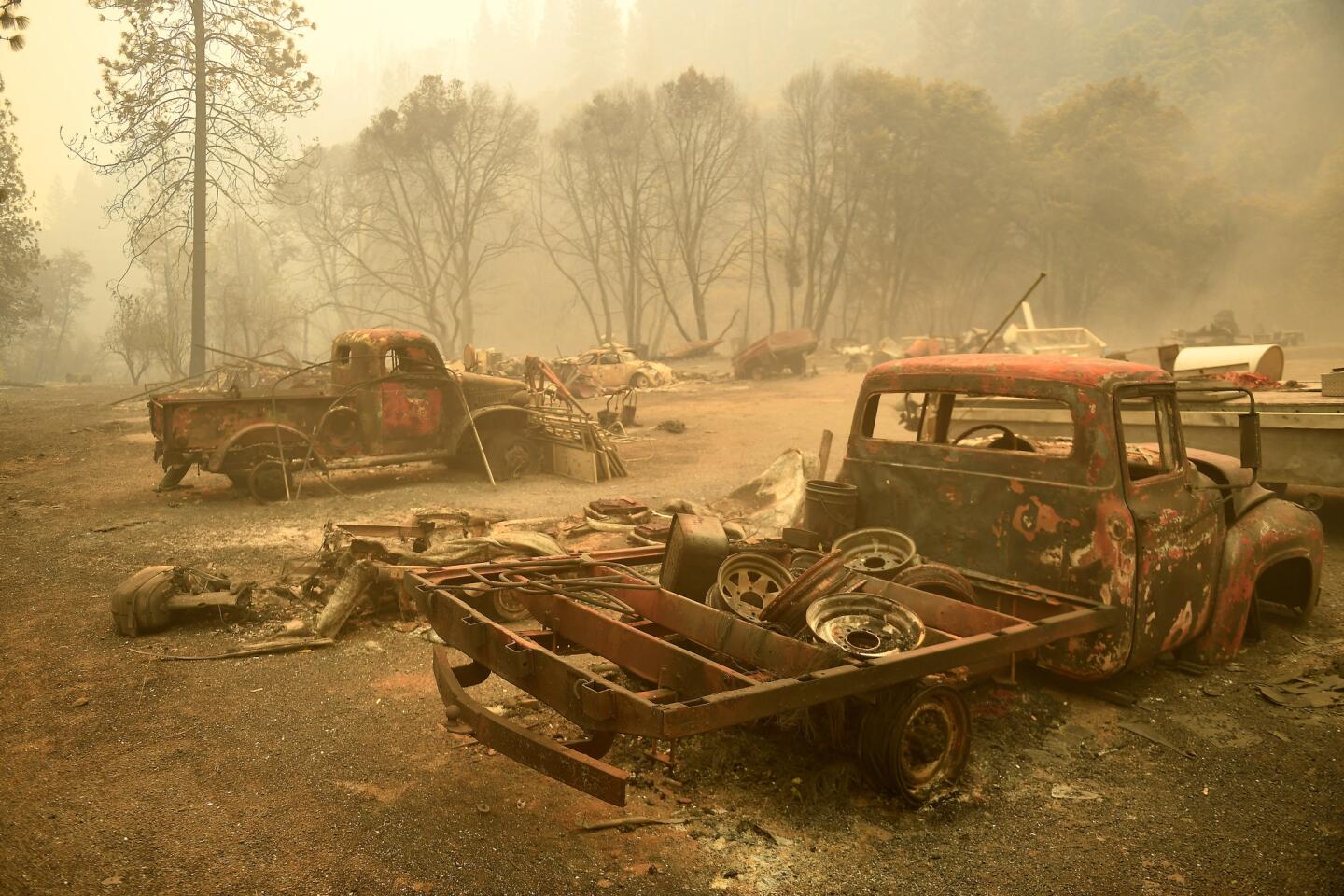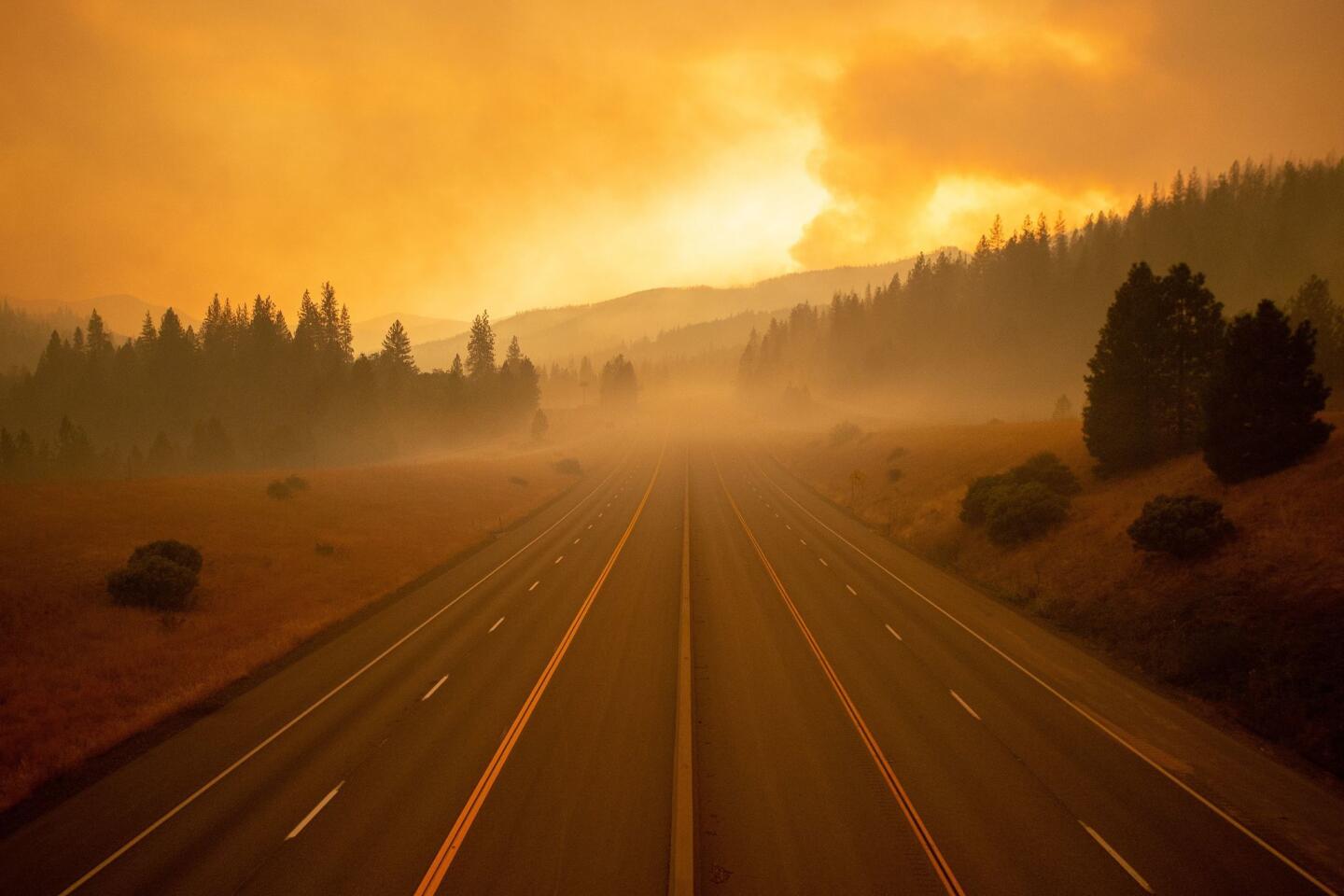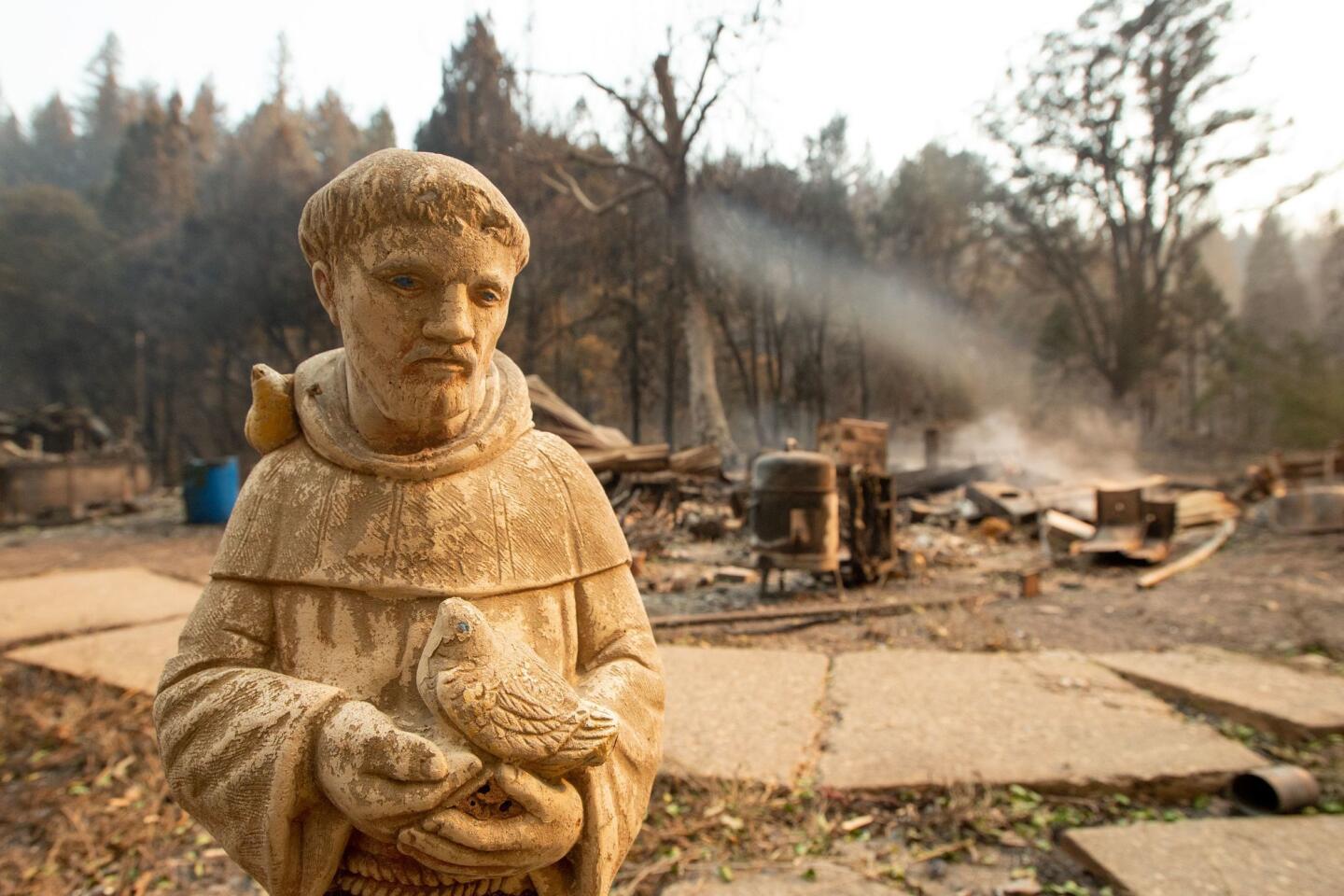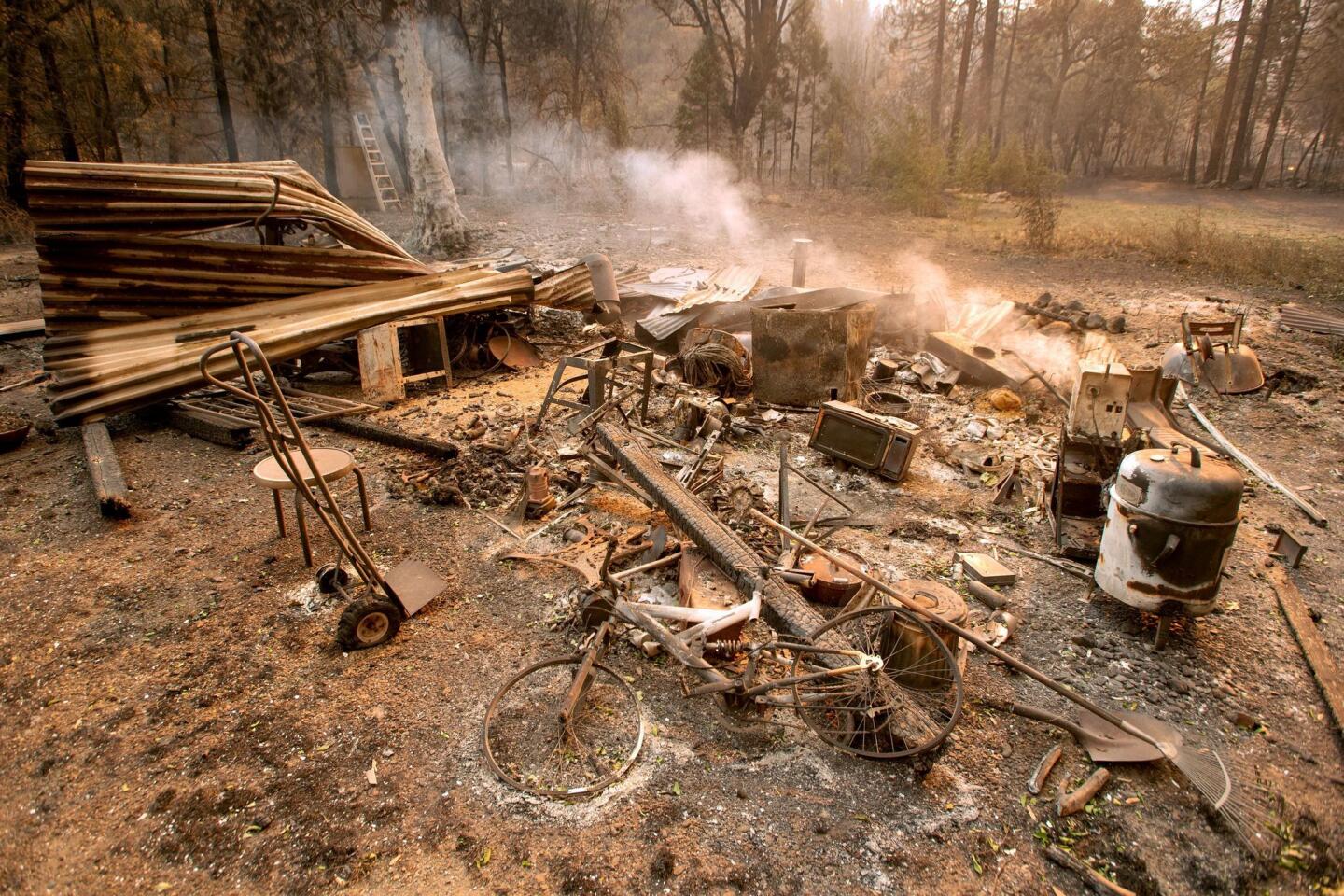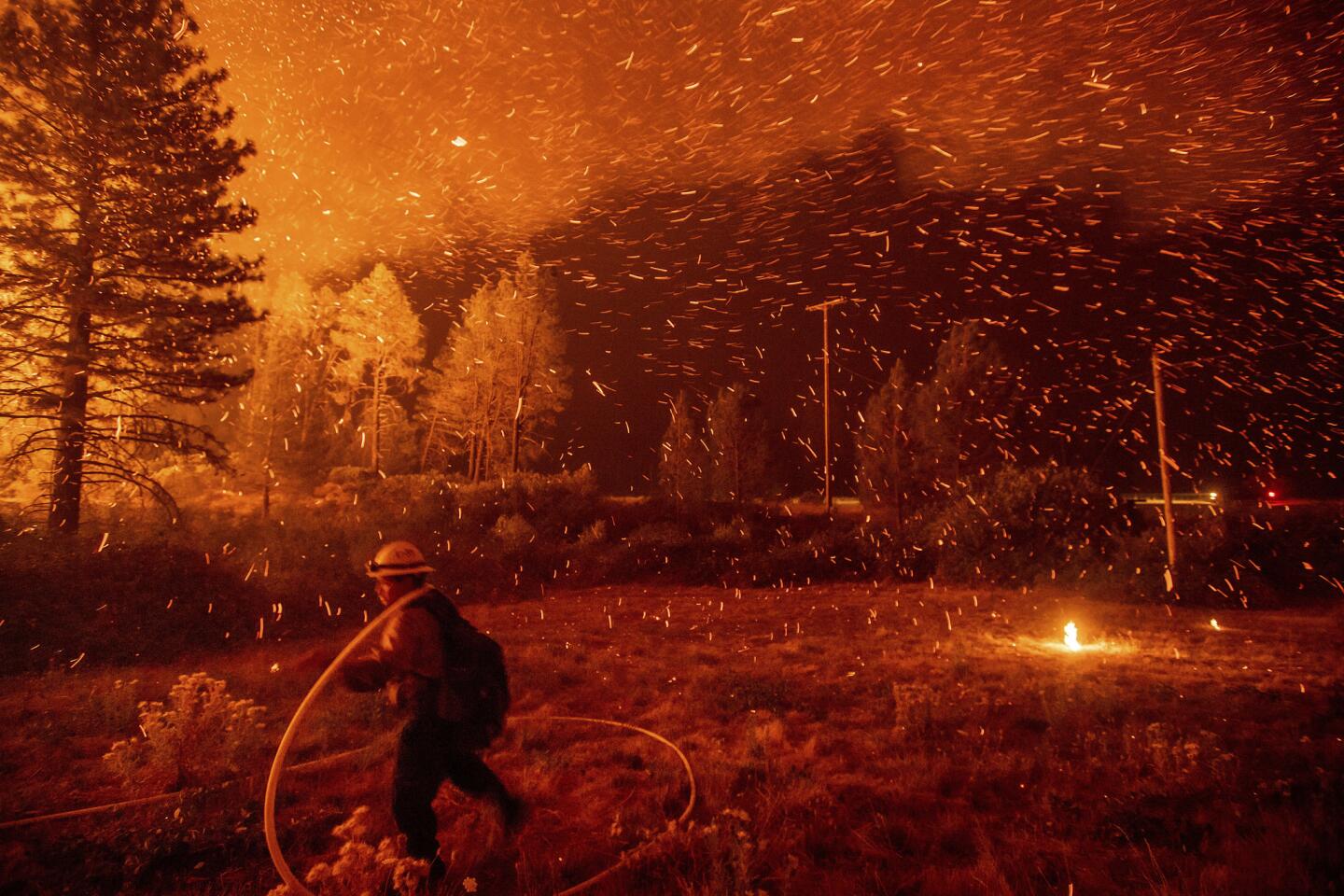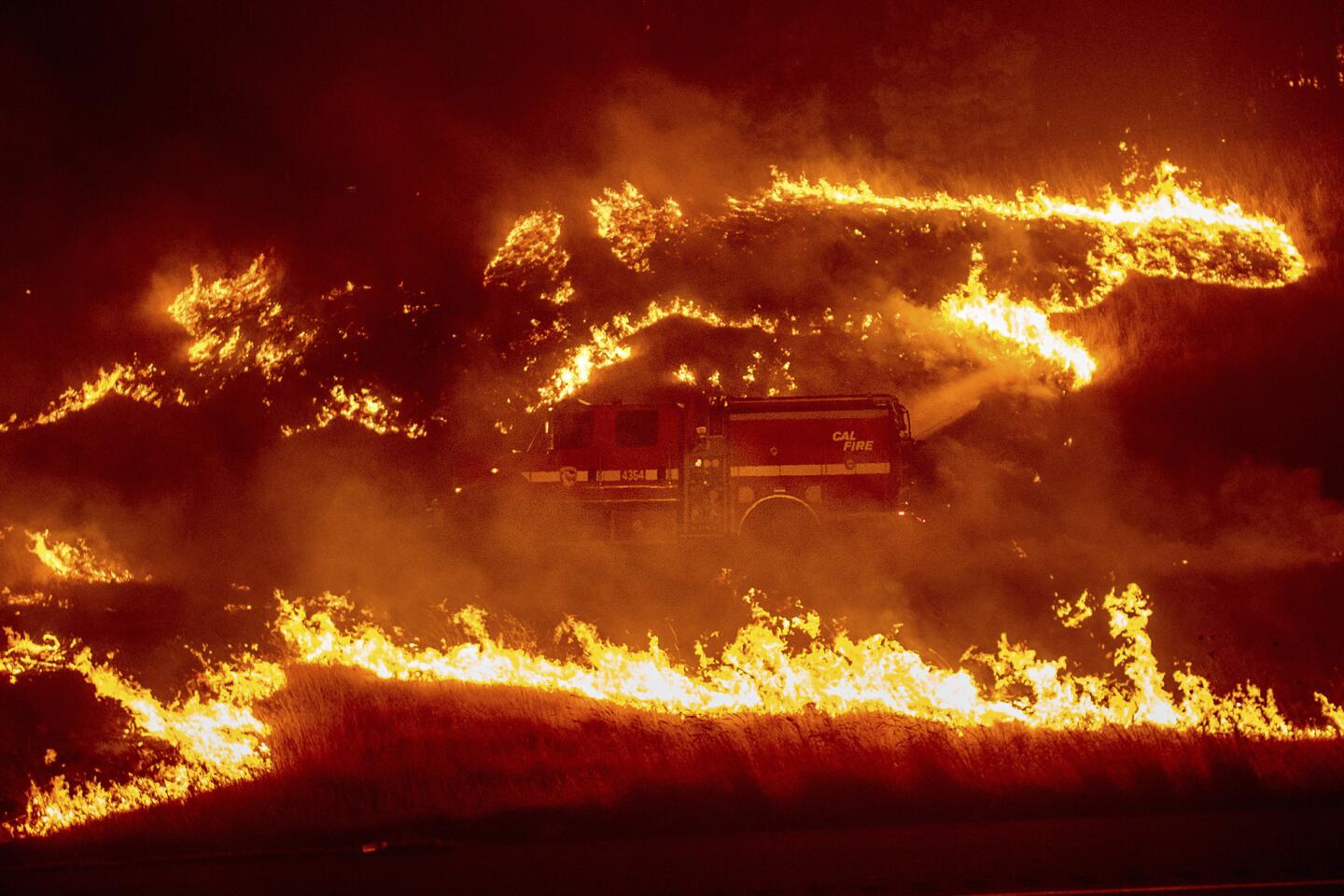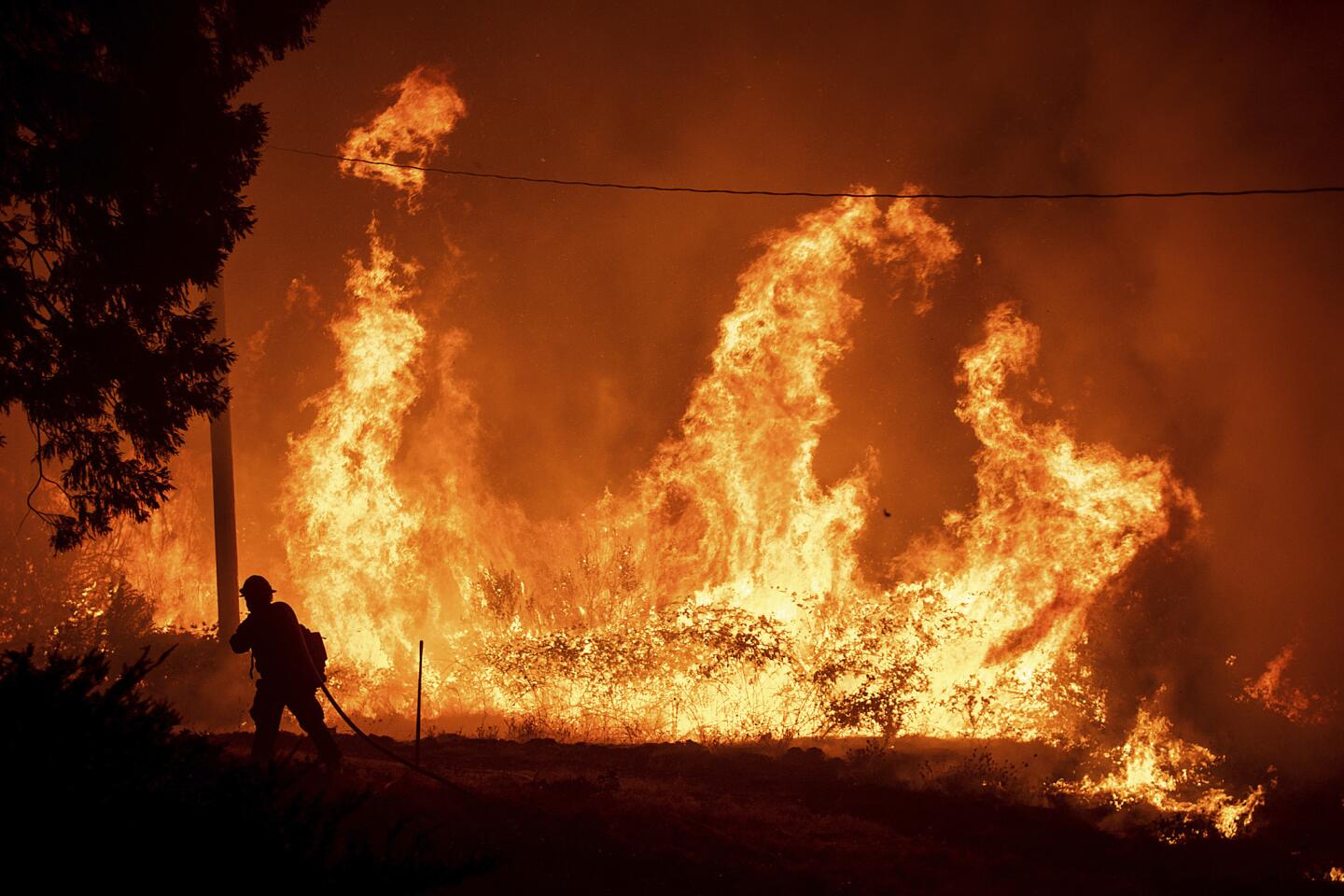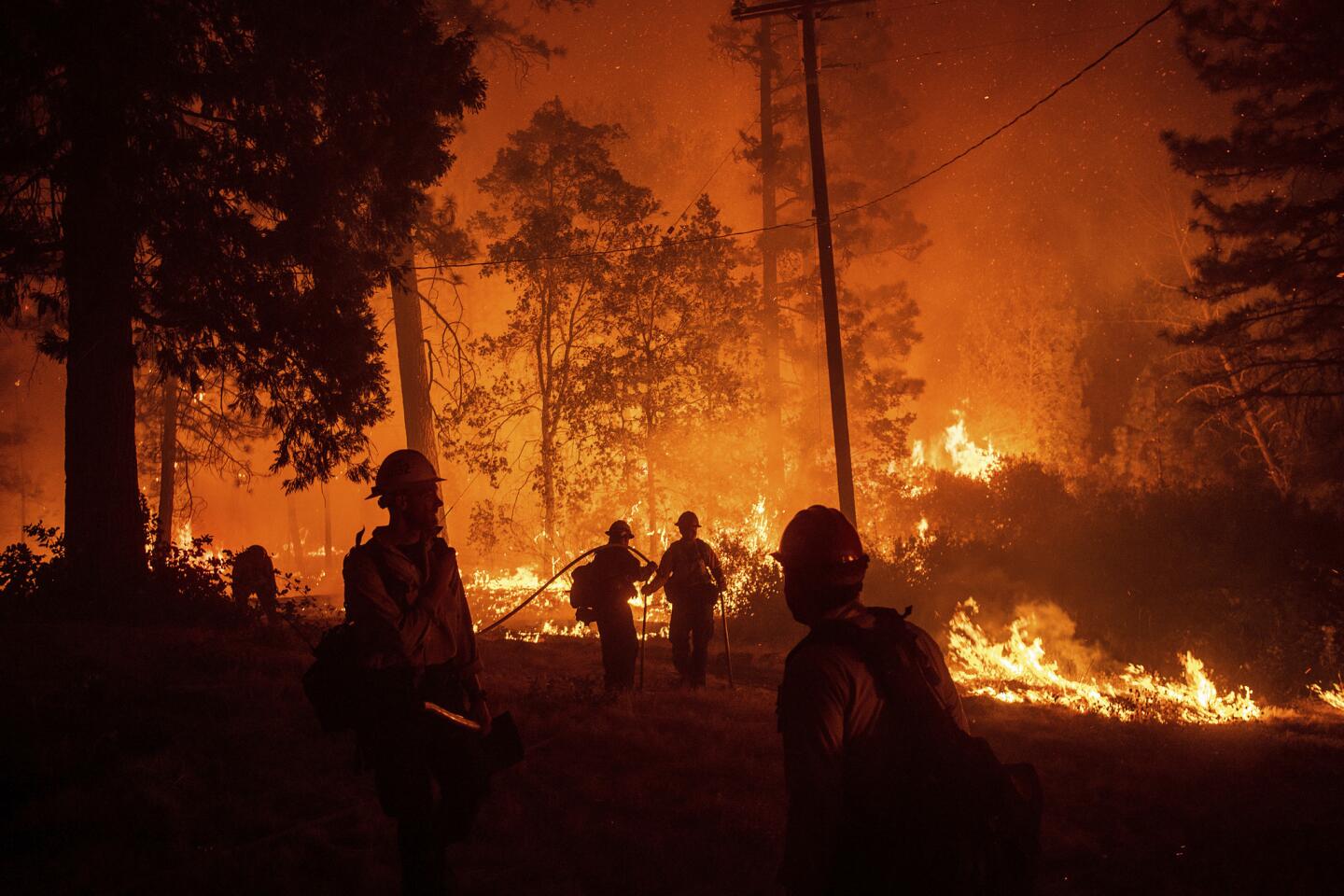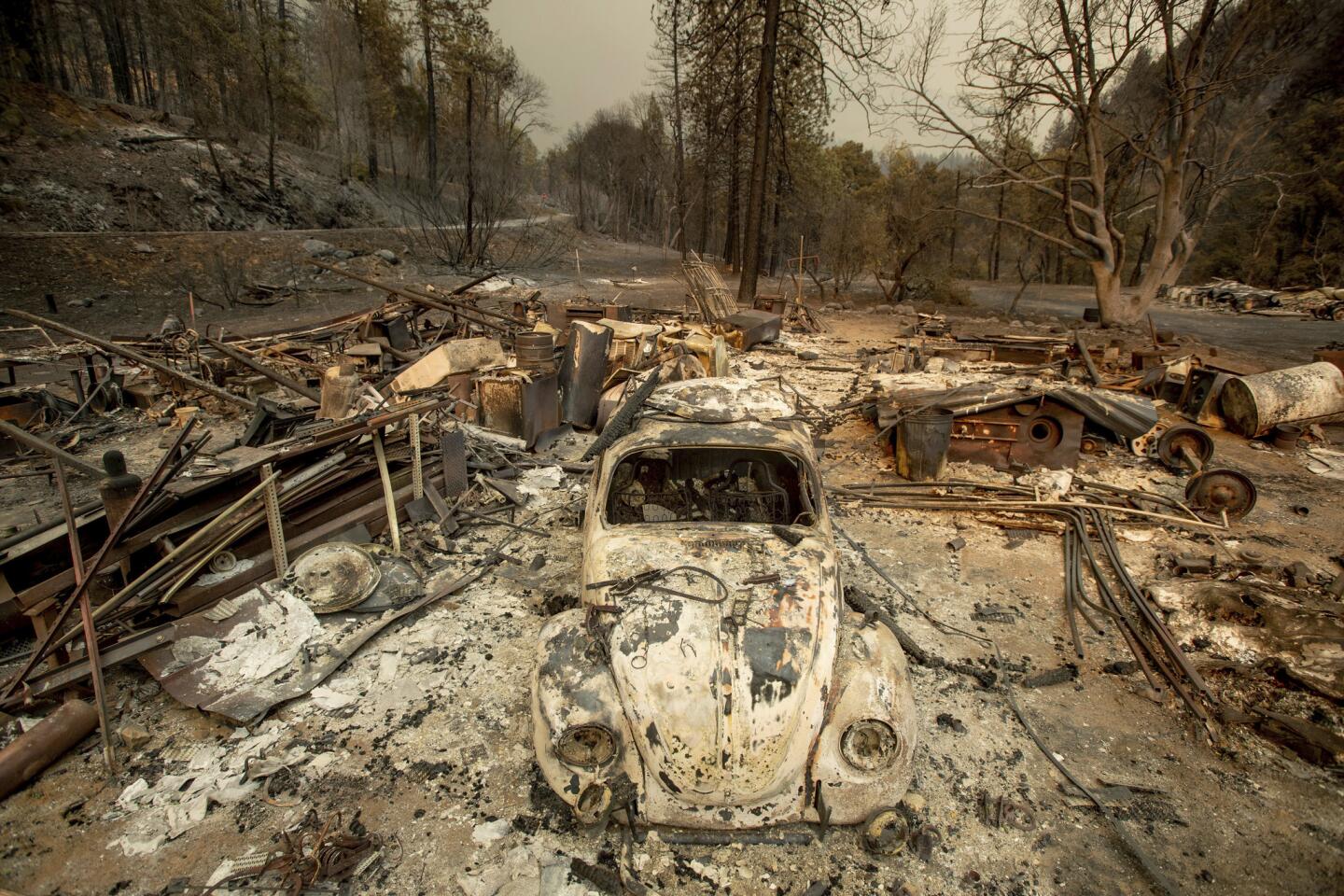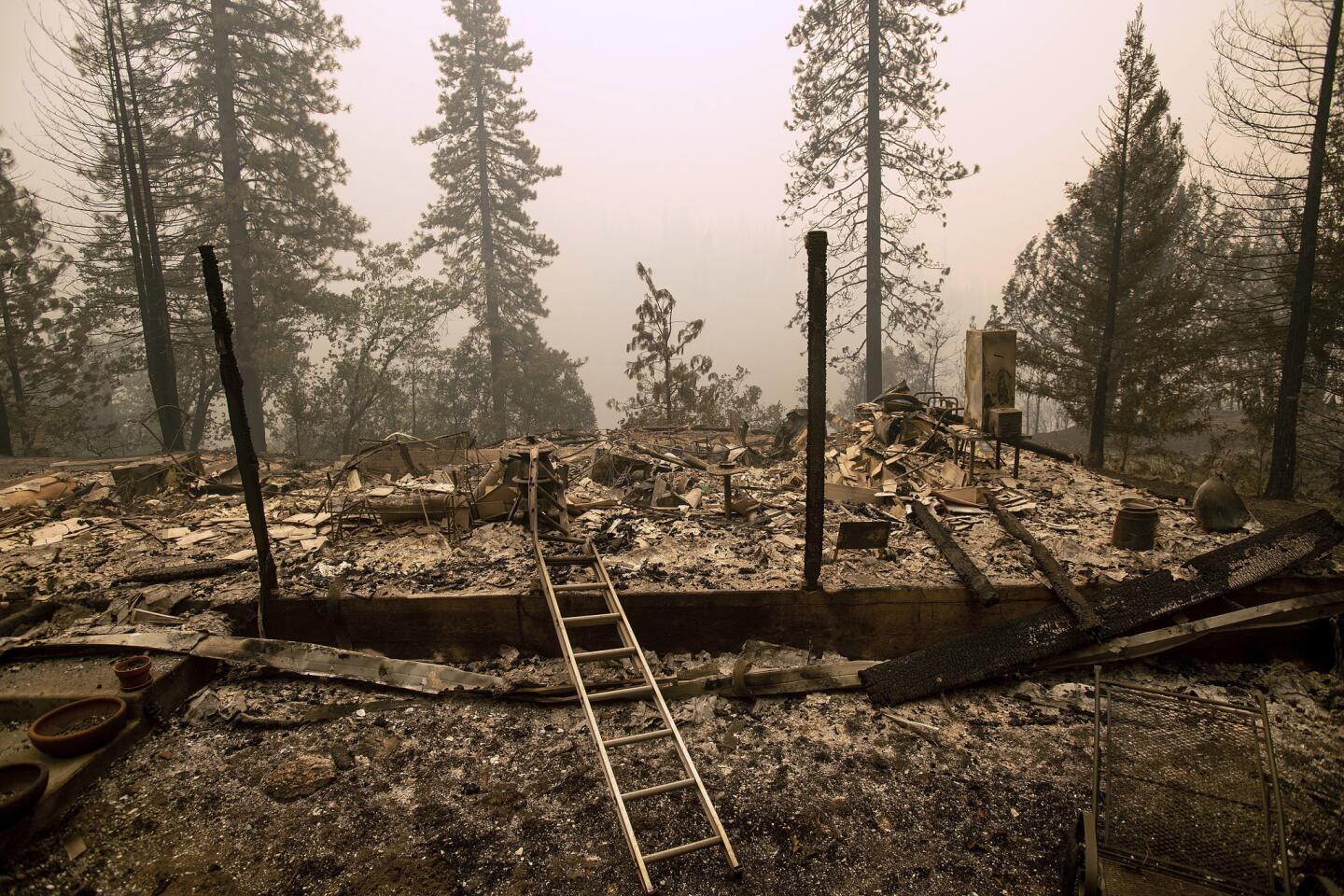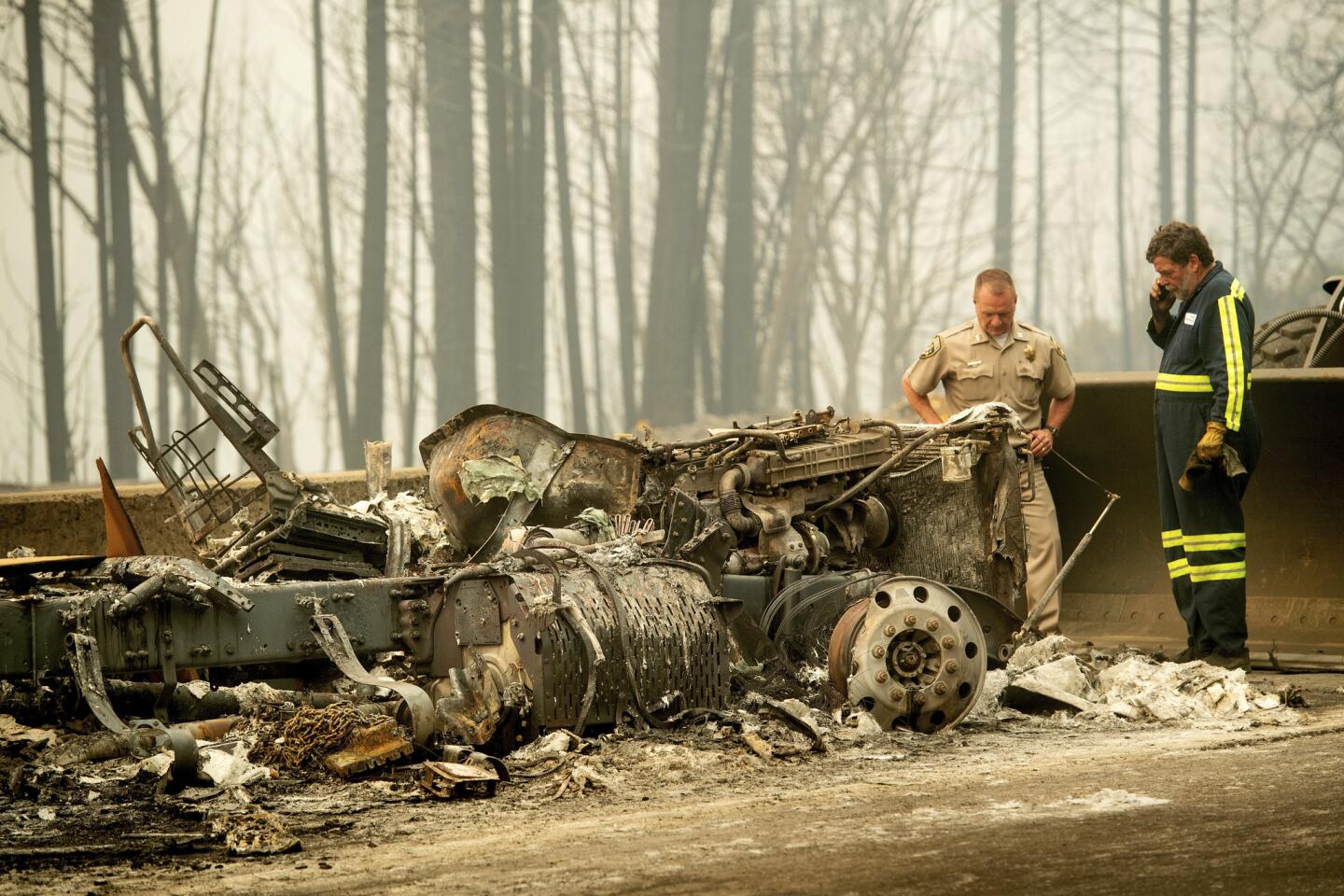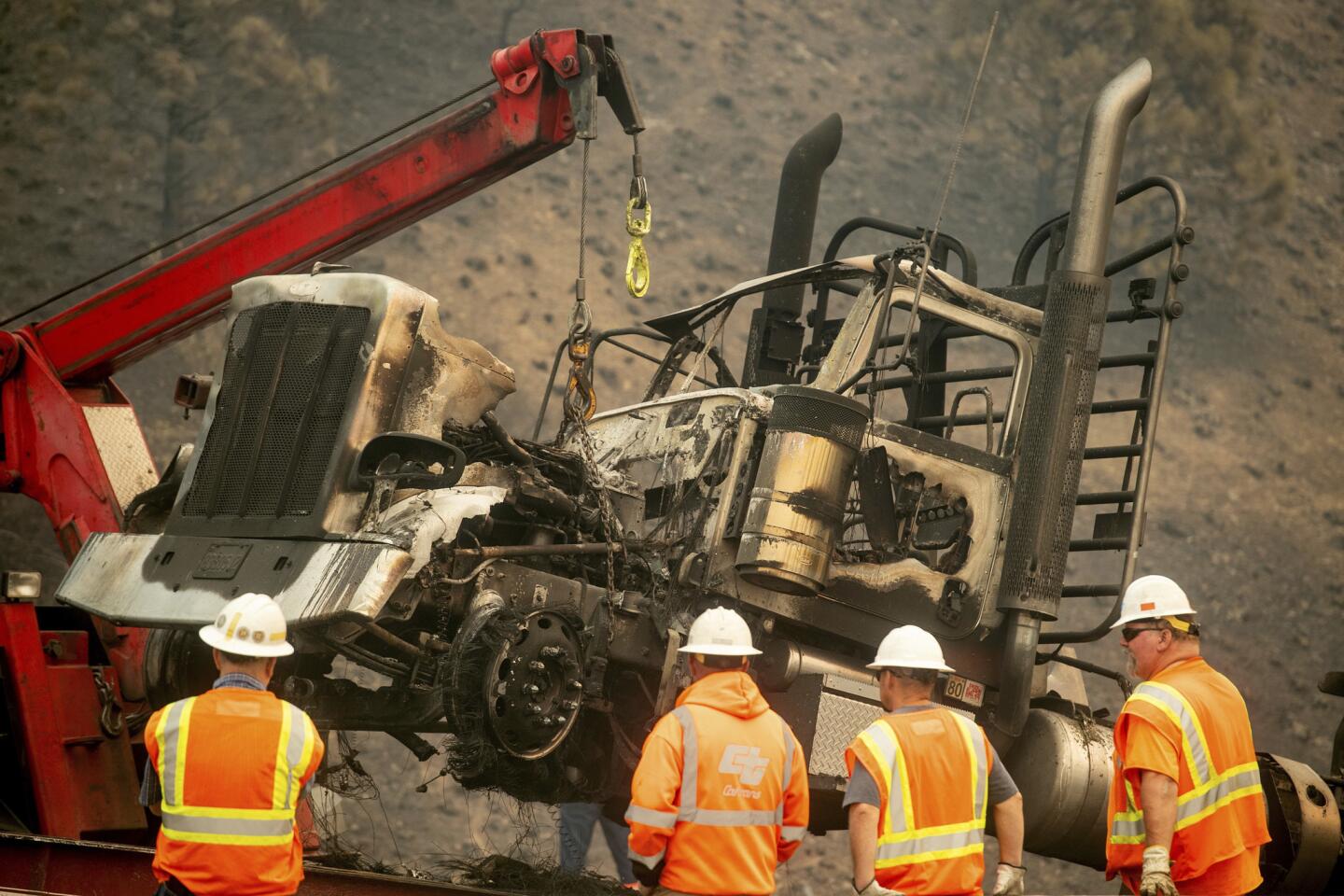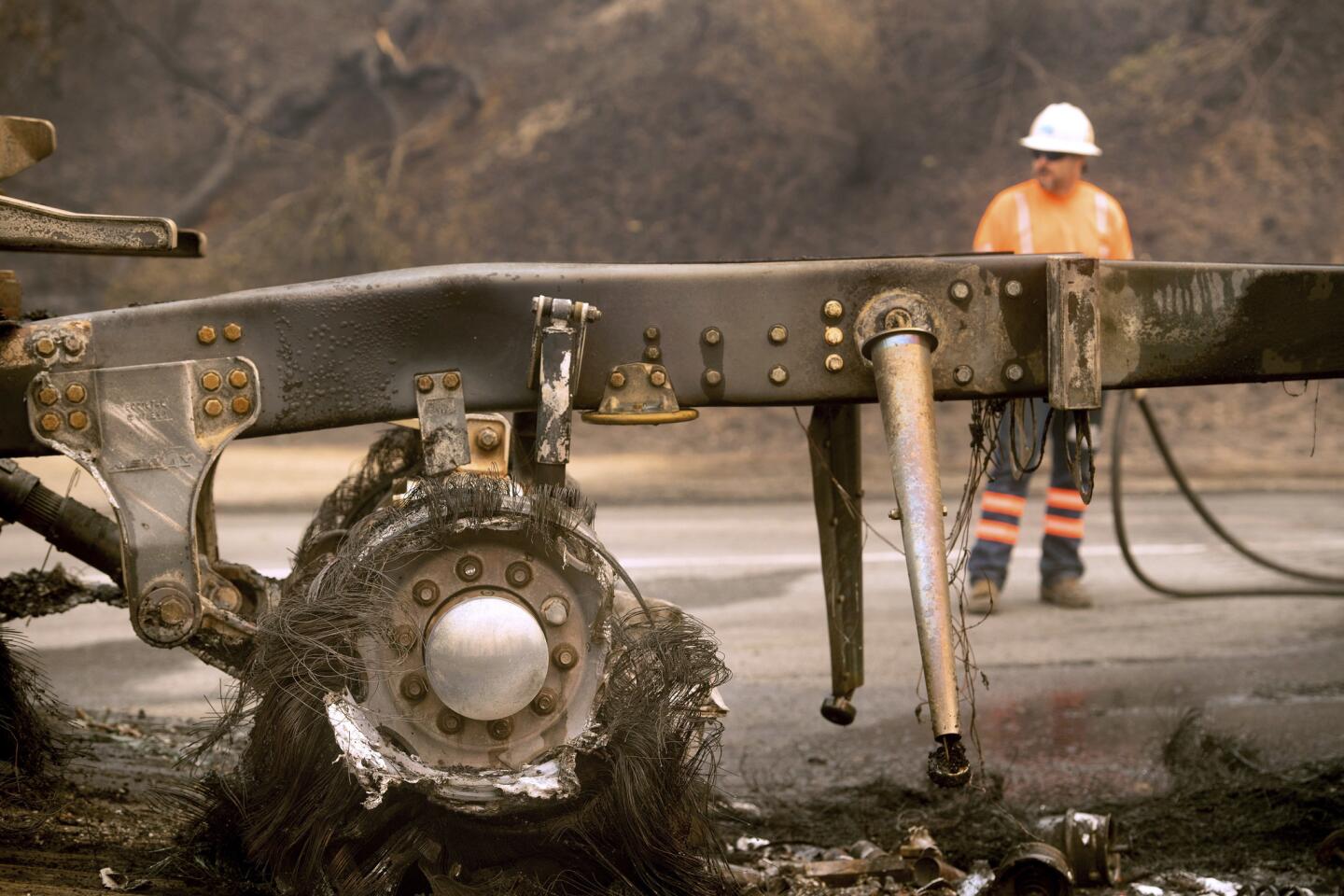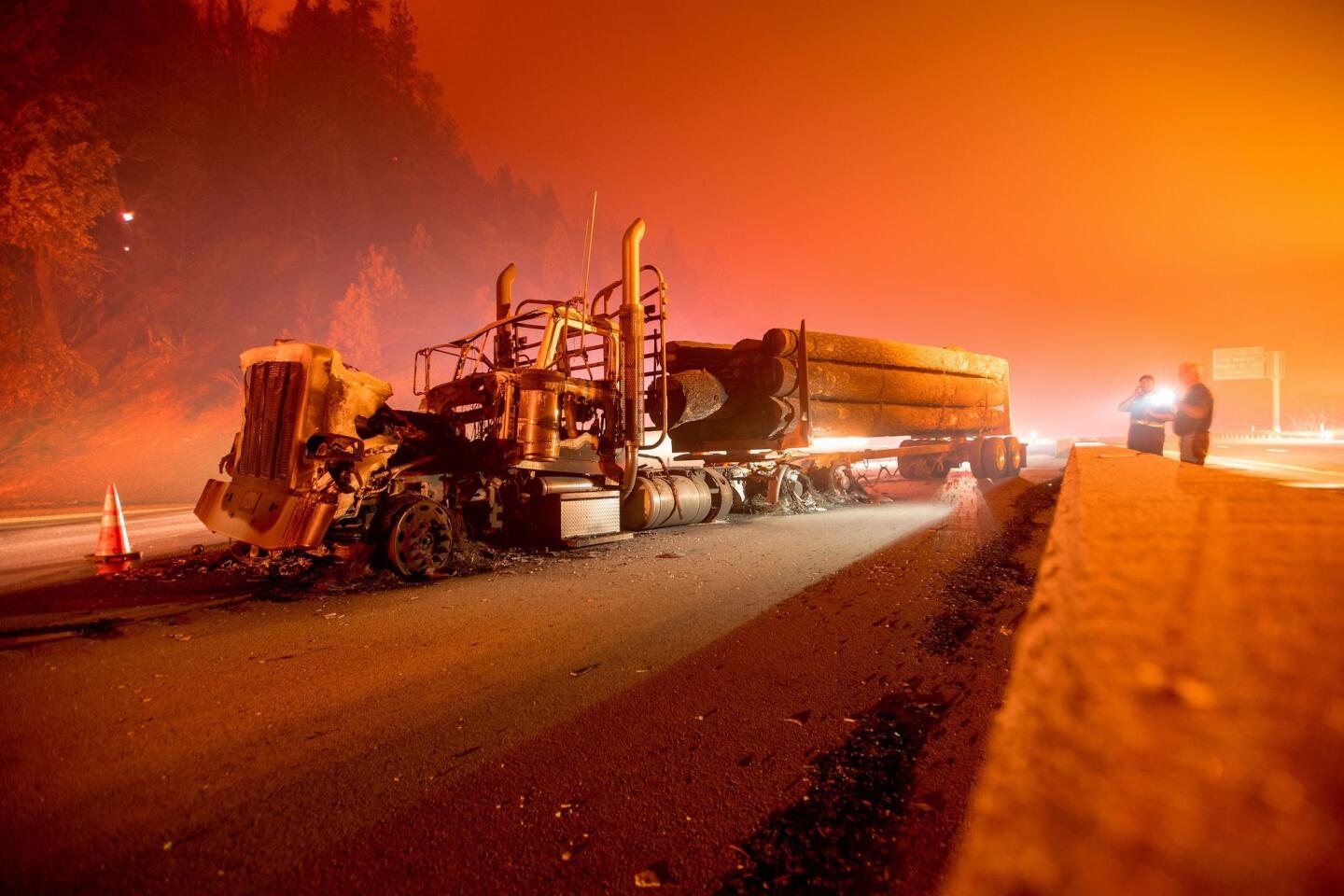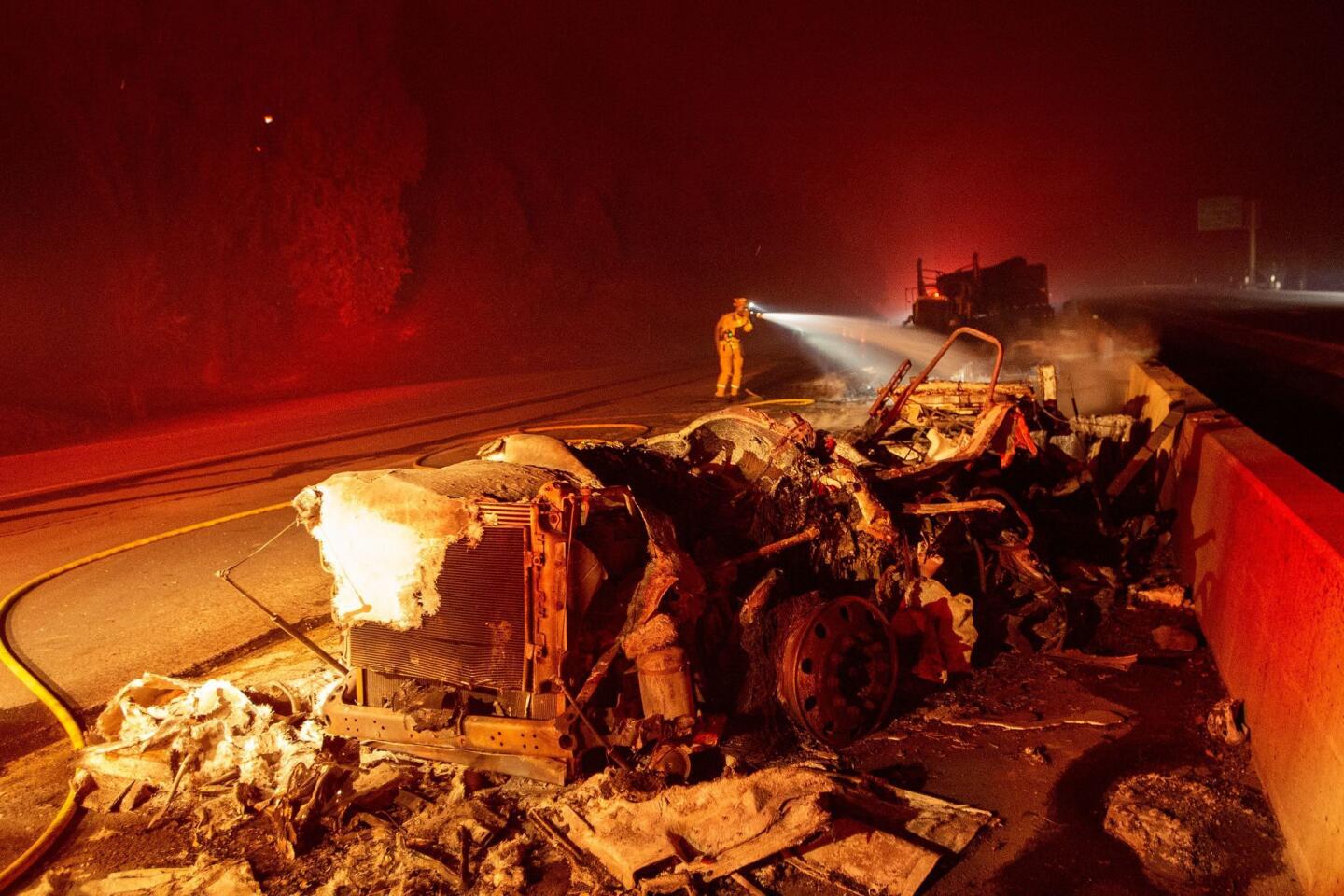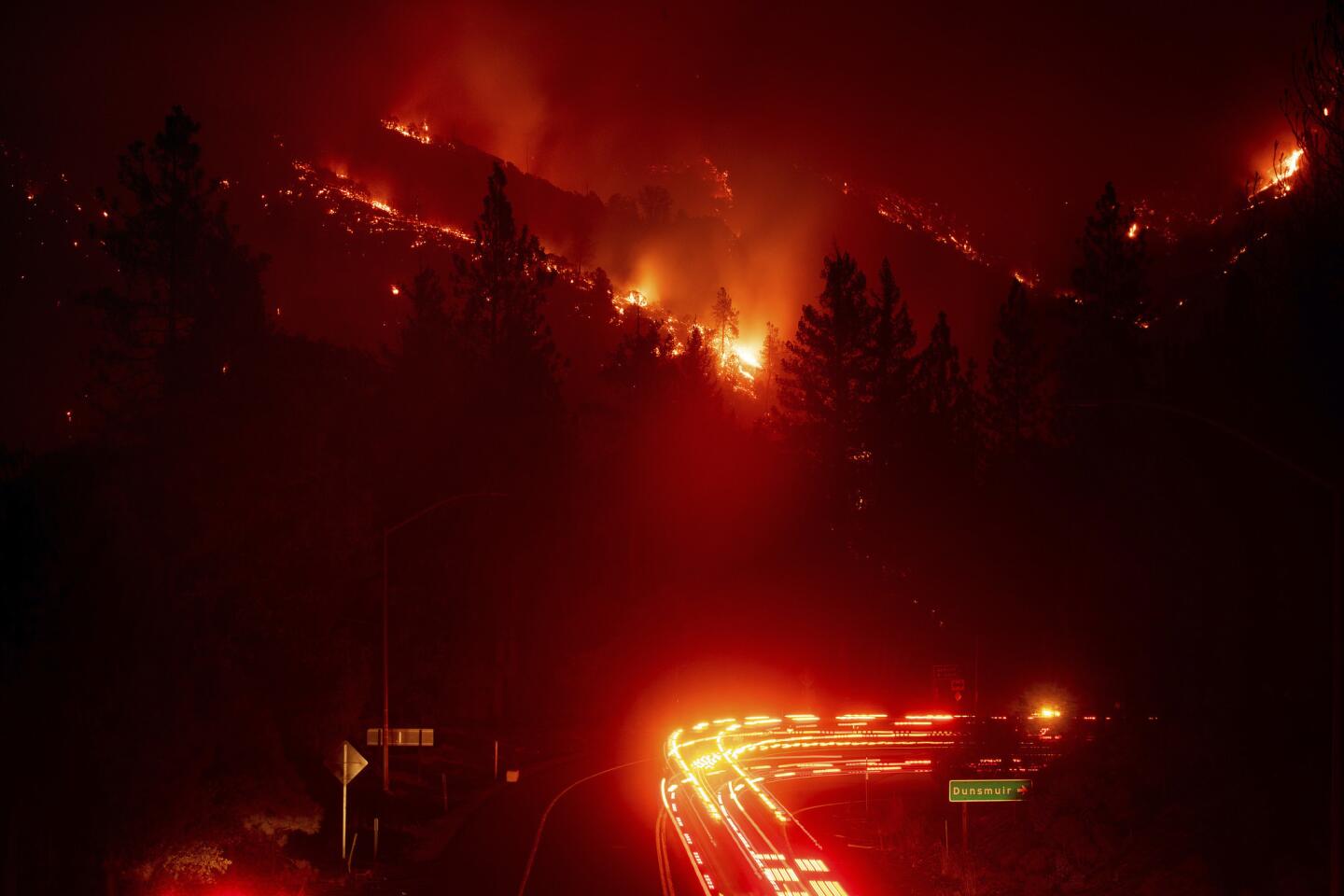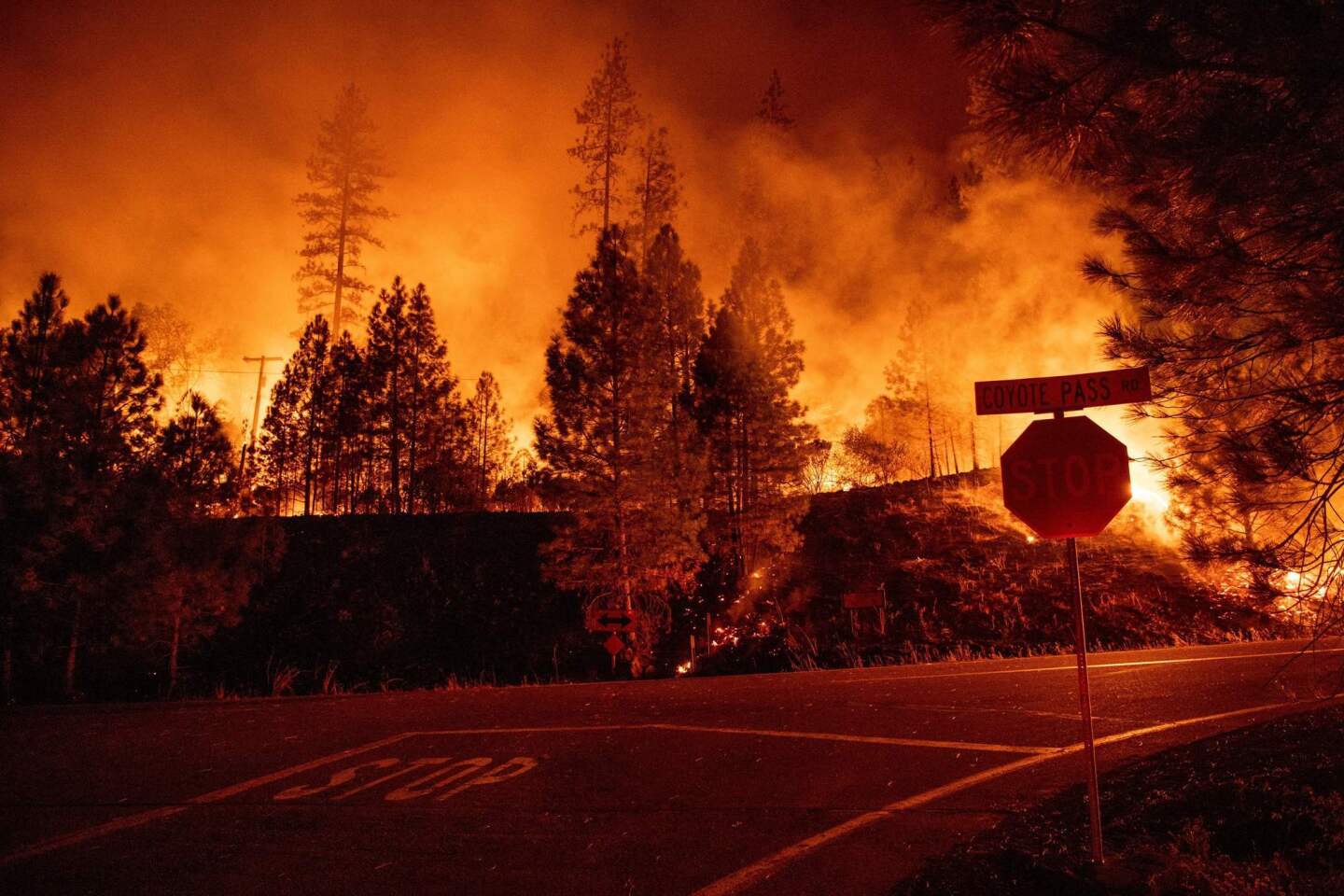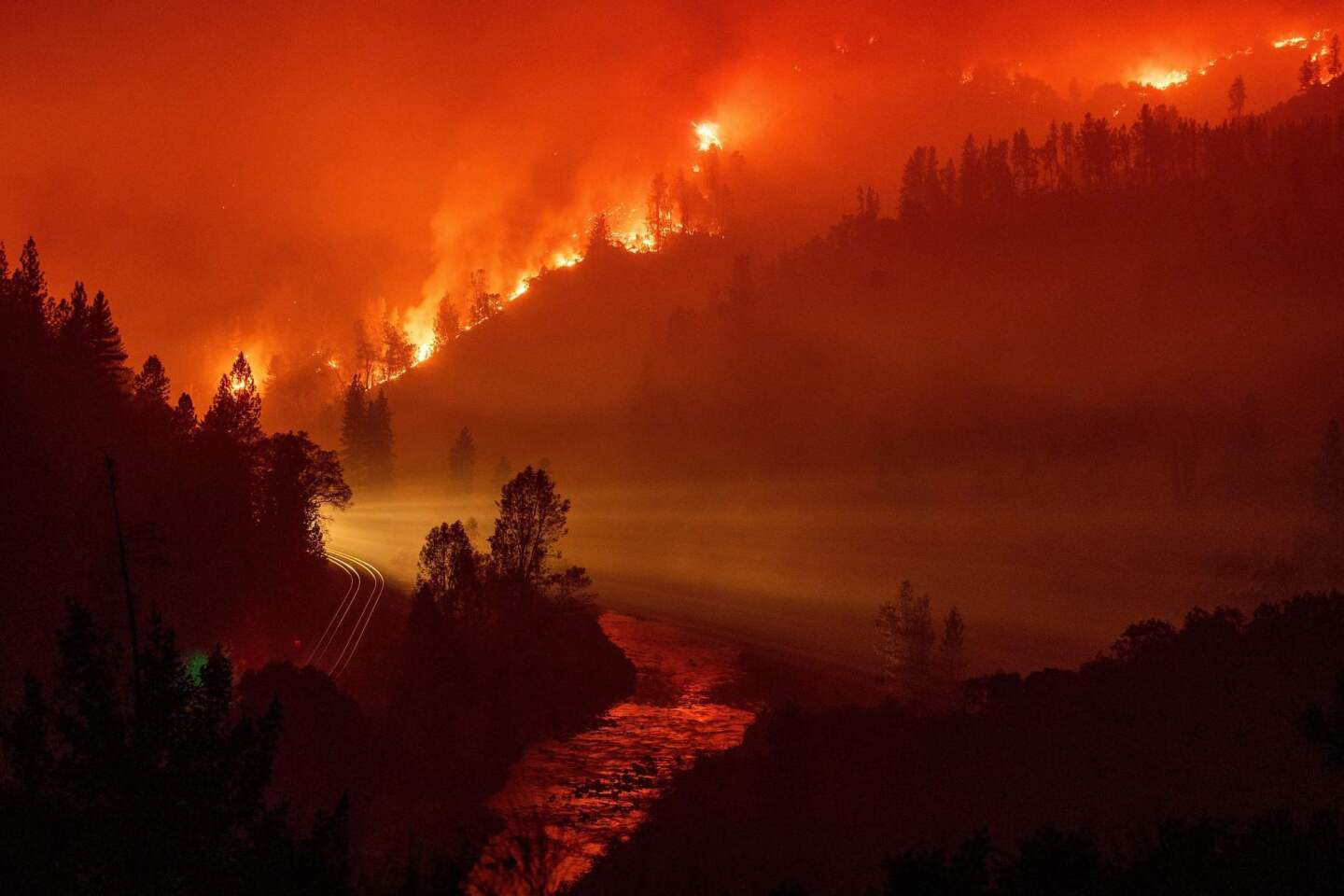Hundreds of drivers fled Interstate 5 as the fast-moving Delta fire surrounded them
- Share via
Rafael Lomeli sat helpless in his truck, surrounded by a wall of flames that had jumped over Interstate 5.
He called his family to tell them he loved them; then he prayed. In the back of his semitruck sat 2,000 gallons of bottled water.
The sky grew dark and cloudy as the wind started to blow. A hellish scene soon developed along the 5 as 300-foot flames burned through tall pines and firs.
One driver stopped in front of Lomeli, got out of his car with a boy and ran in the opposite direction. Several others followed, including a family and about 15 firefighters that had just arrived at the scene. He was about to do the same — until he saw the flames behind him.
The windows of Lomeli’s truck were hot to the touch. He blasted the air conditioning, desperate. All he wanted was to make it home to Yuba City and see his wife and two daughters, ages 3 and 6, again.
The flames swirling around the highway, it was as if Mother Nature was acting like a fire eater, suddenly shooting flames onto nearby drivers, he said.
“It was like a tornado of fire, and we were in the center of it,” the 30-year-old truck driver said in Spanish during a telephone interview.
When the fire started, law enforcement officers were diverting hundreds of cars and trucks to the La Moine exit to turn around, but the blaze started advancing rapidly toward that once-safe location, said Lt. Cmdr. Kyle Foster of the California Highway Patrol’s Mount Shasta office.
Officers had to send cars and trucks through a 12-foot gap in the center median designed for emergency vehicles. Remarkably, they were able to get most vehicles turned around and away from the flames, he said.
About 17 semis were abandoned by drivers who couldn’t maneuver their trucks out in time, and at least four of them were burned.
“The flames were over the tops of trees, 50-foot high, right here on the shoulder on both sides of Interstate 5,” said Sgt. Tim Hinkson of the California Highway Patrol. “It wasn’t like it was a couple hundred feet from the freeway. It was right on top of the freeway.”
Less than 24 hours after the blaze broke out Wednesday in the Shasta-Trinity National Forest, the Delta fire had grown to more than 15,000 acres. By Thursday evening, it had scorched 22,000 acres and was 0% contained. Fire officials feared that once the inversion layer sitting over the fire cleared, the blaze would once again explode through the mountainous forest region, heading farther north toward Gibson, east toward Greens Mountain and west toward Damnation Peak.
By early Friday, the fire could expand east — and possibly merge — with the Hirz fire, a 46,150-acre blaze that’s 80% contained, fire officials said.
At least three homes have been damaged or destroyed, and several more are under threat. About 300 people have evacuated along the 5 from La Moine to the Shasta-Siskiyou county line, said Capt. Brandon Vaccaro, a Delta fire spokesman.
Lakehead resident Stan Kulak fled his longtime home near Pollard Flat after watching 200-foot flames burning through pine trees along the Sacramento River canyon and the interstate.
For decades, the family has lived on 40 acres behind the Pollard Flat restaurant and gas station, about 36 miles north of Redding.
Kulak rushed to pack his wife’s medicines, two family heirlooms — an old wooden clock that has been in his family for more than 100 years and his late mother’s .22-caliber rifle — and most importantly, their Jack Russell terrier, Ducky.
Helicopters hovered and several fire engines surrounded Kulak’s home, his brother’s home and one other house on the property. Firefighters soaked Kulak’s three-bedroom house in water and cleared brush, but they couldn’t keep the fast-moving Delta fire away.
A family friend told the Kulaks that all that’s left standing is the metal door frame.
The 71-year-old Vietnam veteran was grateful his brother woke him up from his afternoon nap when the fire was less than a mile from his house.
“I’ve been shot twice and blown up twice, but [to be killed by] a goddarn fire, that’d be a real pisser, wouldn’t it?” Kulak said.
The blaze forced the closure of about 45 miles of Interstate 5 — the main artery between Redding and the Oregon border. Kulak spent 6½ hours driving from Mount Shasta to Lakehead, stuck in bumper-to-bumper traffic that the local highways rarely see.
Traffic worsened Thursday when a car and a semitruck collided on Route 299 near Oak Run, leaving the truck jackknifed across both lanes of one of the main detours around I-5. By late afternoon, traffic on the winding, two-lane highway hadn’t moved more than a mile in a few hours.
“We’re trying to jam tens of thousands of cars into a single roadway that’s capable of seeing maybe 2,500 cars a day,” said Jason Morton, a public information officer with the California Highway Patrol stationed in Redding.
Union Pacific Railway also shut down its tracks between Redding and Dunsmuir. The company has water cars protecting its tracks and other equipment in areas where it’s safe enough to travel within, spokesman Justin Jacobs said.
Between eight and 15 trains move through the stretch daily hauling a range of goods — including batteries, televisions and cars — that make up roughly the equivalent of about 3,000 semitrucks a day, Jacobs said.
“It’s a pretty significant amount of cargo,” he said.
Much like the massive Mendocino Complex and Carr fires, the Delta fire has been fueled by dry conditions, wind and unforgiving warm temperatures.
There’s not one specific reason the region has been susceptible to fire in recent weeks.
“Maybe it’s a coincidence” that the Delta, Hirz and Carr fires have all ignited in a cluster, making for one of the worst fire seasons Shasta County has seen in decades, said Scott Stephens, a fire sciences professor at UC Berkeley.
Or maybe it has to do with the fact that it’s a heavily forested rural area, broken in some parts only by highways, which makes it so that vehicle sparks are dangerously close to fuel, he said. Stephens said the fires appear to all be human-caused accidents that just happened to ignite in the same area.
The Carr fire, which burned 229,651 acres and killed at least seven people, was started by a vehicle’s flat tire, and Stephens suspects the cause of the Delta fire was also transportation-related.
“This fire is certainly going to be human-ignited because it’s by a transportation corridor,” he said. “I’ve always called people fire magnets, because more people simply means more ignition.”
But Eric Knapp, a fire ecologist based in Redding, said he wouldn’t attribute the cause of this cluster of fires to people alone.
Though the population has been increasing, even in these rural areas, the number of human-caused fires and the number of fires started in general hasn’t increased over time. It’s the number of total acres burned in California overall that has increased dramatically, indicating the fires are simply faster and more intense.
They are also harder to put out, he said.
“This is a really rugged area, and there’s not a lot of people who live there,” he said. “It’s hard to fight fire in this landscape and then you add the fuel accumulation issue and the drought…. It’s just another factor that makes it a challenging area to control once the fire starts.”
The Shasta County area is also susceptible to fires because of its dry coniferous vegetation — large fir, pine and evergreen trees — on steep slopes that make flames travel faster.
“What happens is when a fire goes up a hill, the fire’s flame leans forward and the flame then preheats the fuel that’s in front of the fire,” Stephens said. “So the green fuel is heated by the flame of the fire going uphill, making it much easier to burn.”
Motorists who were stuck on Interstate 5 at the onset of the blaze watched from their vehicles as flames devoured trees and advanced toward the highway. One woman pulled out her phone to document the fire in a video that was posted to social media as traffic remained at a standstill.
“Oh my God, I want to go,” the woman, identified on Instagram as Narraf Ellesse, screamed. “We’ve got to get out and walk. We cannot stay right here.”
She began to sob as the flames jumped along the treetops.
Some truckers unlatched their trailers in an effort to escape the blaze. Others opted to catch a ride with strangers and abandon their vehicles completely.
On Thursday, Lomeli was grateful for his life. The truck driver was able to zigzag around abandoned vehicles on I-5 once the flames died down enough and escape the blaze.
“I just wanted to get out of that mountain,” he said. “It felt ugly. I felt desperation.”
More to Read
Sign up for Essential California
The most important California stories and recommendations in your inbox every morning.
You may occasionally receive promotional content from the Los Angeles Times.
